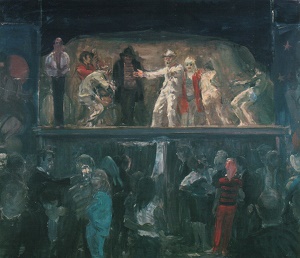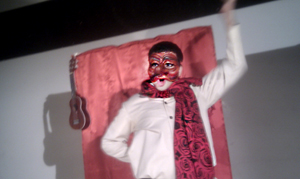Off course there has been jesters and actors around all the time despite prohibitions and censorship. It is just that we have no written witness descriptions since it mostly played in the country side for ordinary people who could not write. But there is laws against them that proves that they have been around.
But we shall not mix up jesters and Commedia dell’Arte actors, even if they are closely related. The jesters had their own professional qualifications. They did not act out plays or performances, their skills were more of circus skills. They were acrobats, jugglers, animal trainers, fire eaters and such. There was a few known professional actors though, like Zan Ganassa who spent a more then 10 years in Spain where he re-created and inspired the Spanish comedy and Zan Polo half a century before him in Italy and France. They were probably some form of mix between jesters and actors, especially Zan Polo.
 When the vendors and street peddlers started entertain the public and turned in to become Charlatani they naturally got more costumers. They often used jesters and acrobats as helpmates or as a form of advertising.
When the vendors and street peddlers started entertain the public and turned in to become Charlatani they naturally got more costumers. They often used jesters and acrobats as helpmates or as a form of advertising.
There were also girls helping out by the booths. Often they were prostitutes – attrice. Their function was, besides from just being a beautiful ornaments (just like modern day car expos), as singers and musicians, sometimes dancers. The girls could also benefit from the fact that the potentates did not differ very much between jester, actors or Charlatani, which may very well be one of the reasons women get the chance to act in Commedia dell’Arte plays as they later got into the mask of the Servetta. The Servetta also had the function in early Commedia dell’Arte performances to act the role of call-boy or rather girl. (Hey, it was the only translation I could find.)
With time the jester’s tricks and the Charlatani’s tirades words and larks developed to more of sketches. From there it grows into plots and into more of ready plots that are being written down to scenarios. Some characters developed from life around them, from carnival masks, fairytales and stories, and so on. They were reshaped to work on stage, just as in all Vulgar Comedy, masks have always grown out of age-old traditions and developed to fulfill new demands .
A good description of what life on the streets and market squares looked like in 1585, by Tommaso Garzonis:
“…Towards the evening the crowd of quacks and blind musicians and acrobats thicken. Here is Zan della Vigna with his performing monkey; Catullo and his guitar; in another corner the Mantuan marry-andrew, dressed up like a zany, Zottino singing an ode to the pox, and the pretty Sicilian rope dancer. Tamburino spins egg on a stick; the Neapolitan capers about with brimming bowls of water on his pate; and Mastero Paolo de Arezzo makes his solemn entry with a waving banner, on which you see St Paul, holding a huge falchion in one hand, while the rest of the field is painted over with twining hissing serpents. The mountebank clears his throat and relates his fabulous pedigree. St Paul was his great ancestor.”
During the medieval times and the renaissance the markets where much more than what mean when we talk about markets. It was not just a place where one could buy and sell things. The markets were folk festivals, among the many other feast days. For example there was a book market in Lyon that lasted four time a year, this means 8 weeks a year of feast.
The markets also had a social function, were people got to meet. We can very well talk about a carnival atmosphere during the markets when people from towns and villages all around came to meet. This is what Bachtin calls “popular-festive forms” (my translation) in his book “Rabelais and his world”:
“…all of these popular-festive forms from the squares lived around the church festivals. A more or less carnivalesque atmosphere were also maintained at the markets (that used to be held at the installations of a church or at a first mass). Finally also private celebrations (such as weddings, baptizings, or funerals) kept some of their carnivalesque inclinations so did the festivities of the countryside such as the wine harvest, the slaughter fest etc. What is common for the carnivalesque in the festiveties is the connections with the cheerful time. Wherever the free and popular aspect of the feast is maintained, the connection with time and the carnivalesque elements are also maintained.”
All this stages of development existed simultaneous on the streets and squares even when Commedia dell’Arte was playing. There are lots of pictures saved from the markets were we can see jugglers, Charlatani, peddlers and Commedia dell’Arte groups working side by side on the places.
Go back to PART 1
See also:
The marketplace
The language of the marketplace
Commedia dell’Arte

Pingback: Charlatano and the square in Commedia dell’Arte (Part 1) |